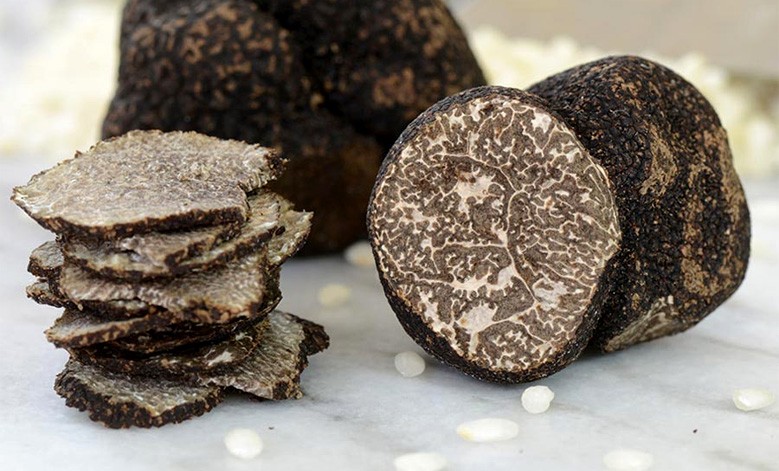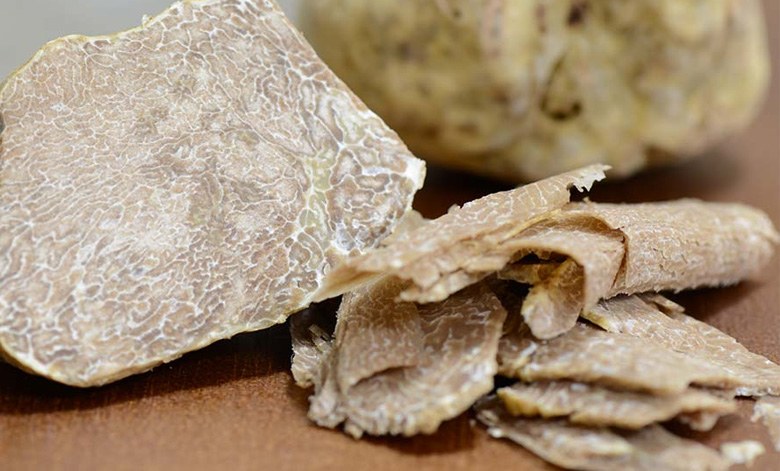There are several hundred types of truffles in the fungi world, but only a select few that are edible, and an even fewer that are sublimely delicious. Let’s explore the different varieties of truffles, their color, their season, their taste, so you know which one you want to try next.

Winter Black Truffle
Tuber Melanosporum; Tuber Brumale Vitt; Extra Melanosporum; Tuber Aestium Vitt; also Asian Tuber Indicum:
Also known by the names of “Périgord Truffle” or “The Black Diamond of Provence”, this is harvested mainly in Italy, Spain, and France, where it grows under the shade of oaks, hazelnut, chestnut elm and poplar trees. The truffle season ranges typically from November to March, peaking in January and February. Contrary to popular misconceptions, no country’s truffle is superior to the other.
Weather disparities between the different regions may produce a bigger crop in one country one year, but a smaller one the next, and also take the season well into the spring. Seasonal variations like rain or frost can also affect availability.
Fresh black truffles are by far the most highly sought-after variety of this mushroom, although they fetch extraordinarily high prices. The winter black truffle is actually more of grayish-brownish black on the outside, with white spidery veins on the inside that indicate maturity (the summer variety will be of a more brownish color, but are the same size). It weighs typically between 2-3oz.
The Winter Black Truffle is highly sought after for its earthy, subtle aroma, and a taste once described as a mixture of “chocolate and earth”.
Winter White Truffle
Tuber Magnatum Pico
This truffle is often called a “Piedmont Truffle” or the “White Truffle from Alba” or “Italian White Truffle”, which indicates where the truffle originates, not the species of fungi.
The only difference between summer and winter white truffles is that one is harvested in the summer and the other in the winter. It’s pretty much straightforward. And the difference between white and black truffles? Let’s find out.
The white truffle is celebrated for its garlicky flavor, reminiscent of shallots, and also an intense earthy and musky aroma. Fresh white truffles are not a pure white, but more of a yellowish color, with a smooth exterior. Although many people call it an “Italian” truffle, because it is mainly found in Northern and Central Italy, especially Piedmont, Tuscany and Marches, you can also find white truffles in Croatia, as well as other parts of Europe.

The main disadvantage of Winter White truffles (or any white truffle for that matter) is that although their aroma is intense, it tends to fade pretty quickly, as opposed to black truffles, which are more subtle, but have a longer longevity. Truffles have gas trapped inside of them, which they release as they are cut or shaved open. Since white truffles have more of this gas, they release more gas, thus are more aromatic. So although intense at the beginning, the gas evaporates and dissipates when the truffle is cooked. Yet this is exactly why white truffles make a magnificent first impression, and why they are primarily used uncooked, mainly shaved or sliced over already prepared dishes, so that their aroma will waft and envelop the dish.
Summer Black Truffle
Tuber Aestivum
Also known as the Truffe de la St. Jean.
Although not held in such high regard as the winter variety, summer black truffles are still a delicious and versatile ingredient. Depending on weather variations, the season for this truffle goes from May to the end of August. They grow among oak, hazelnut, chestnut, elm and poplar trees, much like the winter variety.
Looks: From the outside, it looks pretty much like the Winter Black truffle, with a knobby, roundish shape and dark brown skin. The flesh or interior of the truffle is yellowish-gray, with spidery white veins webbing around. Towards the end of the summer, the flesh turns a darker brown.

The summer black truffle is not as spectacularly fragrant and aromatic as the white truffle, but it does have a very nice perfume, much more subtle, but still quite lovely. They are better utilized by being cooked, to bring out the most of that subtly earthy chocolaty flavor as possible.
Summer White Truffle
Tuber Magnatum Pico, Tuber Borchii
Also known as the Marzuili truffle.
This would probably be your best bet when going for summer truffles. Although not as highly aromatic as the Winter White truffle, the Summer White still has most of that pungency characteristic of white truffles.
It is found in the same regions of Italy as the winter variety, primarily Piedmont, Tuscany and Marches in Italy, and is the exactly same variety of mushroom, only harvested during the summer instead of the winter (black truffles, on the other hand, are a different species altogether in the winter and in the summer).
They are much more affordable than the winter variety, so it allows for more experimentation and more quantity. The flavor is sweet and with hints of garlic, with a musky fragrance. It tends to look the same as Winter White truffles, with the interior going from a smooth yellow color to a dark brown with white veins as the season progresses. As with other white truffles, they are best used sliced or shaved over already cooked dishes, to maximize the aroma of the truffles.
Asian Truffles
The two main types of Asian truffles are the Chinese Black Truffle and the Mid-Eastern Terfez.
The merit of these truffles is highly disputed; some have called them comparable to black summer truffles, others find them completely different to any European truffle.
They look like your average truffle on the outside, knotty and knobby, a dirty black-brown color, smaller than European truffles, about the size of a walnut. On the inside, they are jet black, with white spidery veins and a more elastic consistency.
They are harvested mainly from October to February.
Chinese Black Truffle
Tuber indicum or Tuber sensiese
Also known as the Himalayan truffle, (found in Tibet, Bhutan, Nepal) and the Szechwan and Yunnan provinces in China. Like all other truffles, they grow on the base of trees, typically pine trees or other conifers. They are commonly labeled as Winter Black Truffles, albeit incorrectly
Terfez Truffle
Terfezia bouderi, terfezia spp, or Terfezia claveryi
Also known as “black kame", or the "brown kame” or “desert truffle”.
It originates in the semi-arid regions of North Africa and Middle East, from Morocco to Iraq. This subterranean mushroom grows abundantly underneath the hot desert sand, and has been collected after heavy rainfalls for thousands of years. Today, it is the most widely collected truffle in the world.
They are attributed certain aphrodisiac qualities, and often associated with the cult of the Greek goddess of love, Venus. This truffle is highly perfumed (some would say overpowering), and is traditionally cooked with dishes such as couscous, and is very high in protein. The Terfez is a lighter colored truffle, and the harvesting season goes from late December to early April.